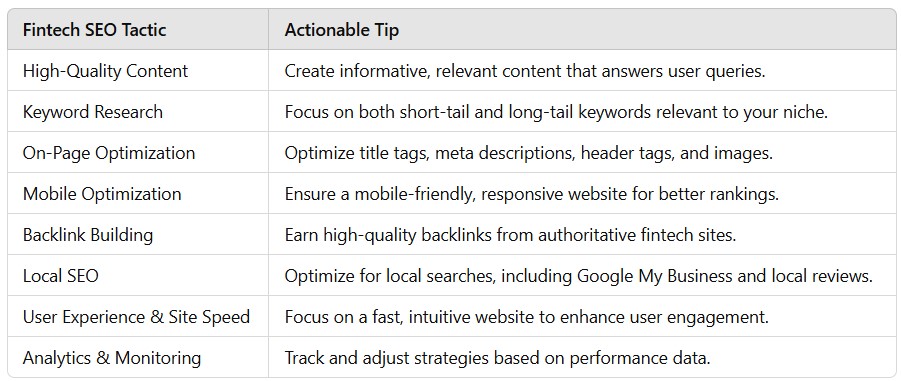In the highly competitive world of fintech, standing out on search engines is critical for growth. Effective SEO practices can significantly boost your website’s visibility, attracting more customers, increasing conversions, and ultimately helping you rank higher on search engine results pages (SERPs). One tool that has gained traction among fintech companies is Rankstar, a platform designed to optimize SEO strategies and improve website rankings. In this article, we’ll discuss the top fintech SEO tactics that can help your business achieve Rankstar rankings and increase online success.
1. Focus on High-Quality, Relevant Content
One of the most effective ways to improve your fintech SEO is by creating high-quality, relevant content that aligns with your target audience’s interests. Content is king in SEO, and this holds true for fintech as well. Your content should not only be informative but also answer the specific questions potential customers are asking.
Example: For a fintech company offering investment advice, a blog post titled “How to Choose the Right Investment Strategy for Your Future” can target keywords related to investing, financial planning, and wealth management. This type of content not only adds value but also helps build authority in the niche.
Tip: Regularly updating your content and providing fresh insights on fintech trends can also keep your audience engaged and improve your website’s SEO performance.
Statistics: According to a study by HubSpot, businesses that blog regularly generate 67% more leads than those that don’t.
2. Keyword Research and Optimization
Effective keyword research is the foundation of any SEO strategy. For fintech companies, identifying the right keywords to target can mean the difference between ranking on the first page or slipping into obscurity. Use tools like Google Keyword Planner, SEMrush, and Rankstar‘s SEO tools to identify high-volume, low-competition keywords specific to your niche.
Example:
If you’re offering a lending service for small businesses, targeting long-tail keywords like “best small business loans for startups” can help you capture more relevant traffic.
Tip: Focus on both short-tail and long-tail keywords, as they serve different purposes in attracting both broad and highly targeted traffic. Additionally, ensure that the keywords appear naturally in your content, titles, meta descriptions, and URLs.
3. On-Page Optimization for SEO
On-page SEO refers to optimizing the elements on your website that impact rankings. This includes title tags, meta descriptions, header tags, URL structure, and image alt texts. A strong on-page SEO strategy can significantly improve your chances of ranking well on Rankstar and other search engines.
Title Tags and Meta Descriptions:
Ensure your title tags are descriptive and concise (under 60 characters), and your meta descriptions should be around 150-160 characters. Both should include your target keywords while encouraging users to click.
Header Tags (H1, H2, etc.):
Organize your content using header tags. This not only makes your content more readable but also helps search engines understand the structure of your content.
Example:
For a fintech company offering credit repair services, an H1 tag could be “Top Credit Repair Tips for Building a Better Financial Future,” with H2 tags breaking down various tips or strategies.
Tip: Use internal linking within your content to guide users to other relevant articles, increasing time on site and reducing bounce rates, both of which are important for SEO.
4. Mobile Optimization
With over 50% of global web traffic coming from mobile devices, mobile optimization is no longer optional—it’s essential. Google now uses mobile-first indexing, meaning that Google primarily uses the mobile version of your site for ranking and indexing.
Example:
If your fintech website isn’t mobile-friendly, users may experience difficulties navigating, leading to higher bounce rates and lower rankings.
Tip: Ensure your site has a responsive design, fast loading times, and easy navigation across all devices. Rankstar can help optimize your mobile site performance, improving the user experience and ultimately boosting rankings.
5. Building High-Quality Backlinks
Backlinks are one of the most powerful ranking factors in SEO. They signal to search engines that your content is valuable and trustworthy. However, not all backlinks are created equal. To achieve Rankstar rankings, focus on acquiring backlinks from authoritative, relevant sources within the fintech industry.
Example:
Reach out to well-established fintech blogs or industry leaders for guest blogging opportunities or to be featured in their content. A link back to your site from a reputable source can significantly increase your authority and improve rankings.
Tip: Avoid link-building tactics that violate search engine guidelines, such as purchasing backlinks. Instead, focus on earning them through valuable, shareable content.
6. Local SEO for Fintech Businesses
Local SEO is especially important for fintech businesses targeting specific geographic regions. By optimizing your website for local searches, you can increase your visibility among customers searching for local fintech solutions.
Example:
If you offer financial planning services in Colorado, target keywords like “best financial planner in Colorado Springs.” This will help your website rank higher for local searches and attract customers within your region.
Tip: Claim your Google My Business listing, ensure that your NAP (Name, Address, Phone number) information is consistent across all directories, and collect positive reviews from satisfied customers to improve your local search rankings.
7. User Experience (UX) and Site Speed
Search engines like Google place a significant emphasis on user experience (UX). A fast-loading website with intuitive navigation and a smooth user experience is more likely to rank well. Rankstar helps you analyze your site’s UX performance and offers tools for improving speed.
Example:
If your fintech website takes more than 3 seconds to load, you risk losing a substantial portion of visitors. According to a report from Google, 53% of mobile users abandon a website if it takes longer than 3 seconds to load.
Tip: Use tools like Google PageSpeed Insights or Rankstar to identify and fix performance issues that may hinder your site’s loading speed.
8. Analytics and Monitoring
Once you’ve implemented your fintech SEO strategy, it’s crucial to monitor your performance and make data-driven adjustments. Use tools like Google Analytics, Google Search Console, and Rankstar‘s performance analytics to track your keyword rankings, traffic, and conversion rates.
Tip: Regularly analyze your data to identify areas for improvement. If certain pages aren’t performing as expected, consider revisiting your content strategy or enhancing the on-page SEO for those specific pages.
fintech seo rankstar
Achieving Rankstar rankings for your fintech business requires a comprehensive SEO strategy that includes high-quality content, thorough keyword research, on-page optimization, and a focus on user experience. Additionally, by focusing on mobile optimization, building high-quality backlinks, and leveraging local SEO, fintech companies can improve their online visibility and attract more potential customers. Remember to regularly monitor and adjust your strategy to stay ahead of the competition. By integrating these top fintech SEO tactics, your business will be well on its way to securing a prominent spot on search engine results pages.
Key Takeaways

FAQs: fintech seo rankstar
- What is fintech SEO?
- Fintech SEO involves optimizing a financial technology business’s website to rank higher in search engines, using tactics like content creation, keyword research, and backlink building.
- How does Rankstar help with SEO?
- Rankstar provides tools for keyword tracking, on-page SEO analysis, and site optimization, helping businesses improve their rankings on search engines.
- What is the best keyword strategy for fintech businesses?
- Focus on both broad, high-volume keywords and specific long-tail keywords that address niche fintech topics relevant to your audience.
- Why is mobile optimization important for fintech SEO?
- With mobile-first indexing, having a mobile-optimized site ensures better rankings and user engagement, which is crucial for fintech businesses.
- How do I build high-quality backlinks?
- Build backlinks through guest blogging, partnerships, and creating shareable content that reputable websites want to link to.
- What tools can I use for tracking fintech SEO performance?
- Tools like Google Analytics, Google Search Console, and Rankstar can help track rankings, traffic, and conversions to optimize your SEO efforts.











